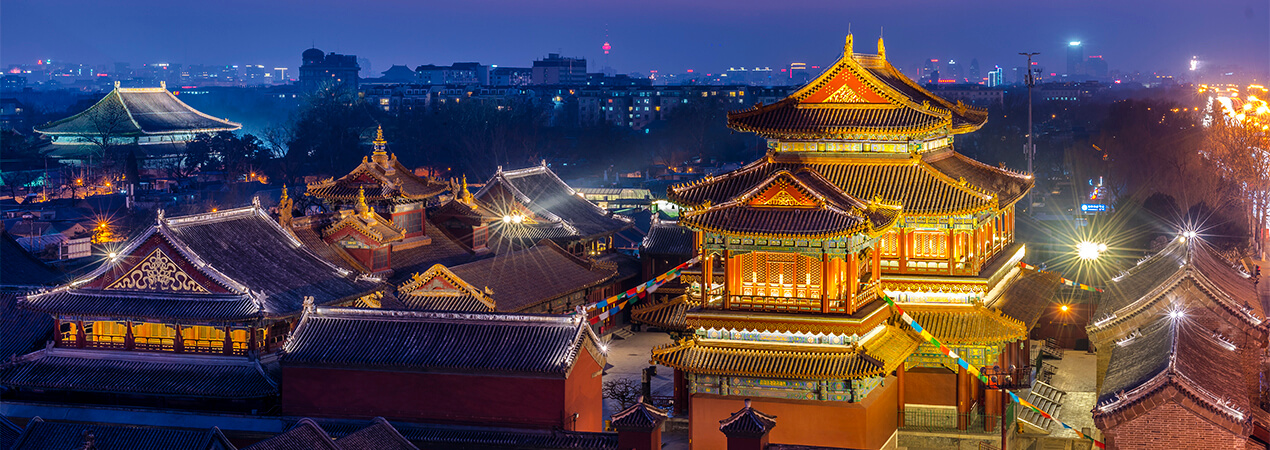Lama Temple

Lama Temple is the largest imperial Tibetan Buddhist temple of the Gelugpa sect (Shamanism) in Beijing City. Here is the former residence of Prince Yinzhen, the fourth son of Emperor Kangxi in the Qing Dynasty, and the birth place of Emperor Qianlong. Later, the site was changed into a Shamanist temple attracting a lot of pilgrims. Valuable ancient buildings and cultural relics inside the Temple are worth visiting.
- Chinese Name: 雍和宫 Yōng Hé Gōng
- Built in: 1694
- Duration: 1-2 hours
- Entrance fee: RMB 25
- Opening hours: Access all year April 1st – October 31st: 09:00 – 16:30 November 1st – March 31st next year 09:00~16:00
- Address: 12 Yonghegong Street, Beixinqiao, Dongcheng District, Beijing City
- Best time to visit: Access all year
- How to get there:
Take Bus 116 or 117 and get off at Lama Temple Station
Subway: Take Line 2 or 5 and get off at Lama Temple Station
Highlights of Lama Temple
1. Unique buildings
 the buildings in Lama temple
the buildings in Lama temple With a total area of 66,400 sqm, and a history of about 300 years, Lama Temple boasts over 1,000 shrine buildings, including Memorial Archways with overhanging eaves and brackets and Shushan Buildings in the east and west. Lama Temple is composed of the Heavenly Kings Palace, Lama Temple Hall (Main Hall), Yong-woo Hall, Falun Hall, and Wanfu Club, together with side halls in the east and west, and Exoteric Hall, Esoteric Hall, Mathematics Hall as well as Medicine Hall. The overall layout of the Temple narrows down gradually from south to north while the heights of the Halls increase conversely, presenting the grand visual effect of “tall Main Hall in deep yard” with the features of Han, Man and Zang nationalities.
2. Combination of Han and Tibetan Buddhism
Lama Temple combines Han Buddhism and Tibetan Buddhism. You can find the statue of Maitreya Buddha from Han Buddhism in the Heavenly Kings Palace and the gilded bronze statue of Lama Tsong Khapa from Tibetan Buddhism in the Falun Hall. The arrangements of Four Heavenly Kings in the Heavenly Kings Palace and Buddhas of Three Periods in the Lama Temple Hall are slightly different from those in the Han Buddhist temples.
3. Valuable Cultural Heritage
Tributes paid by the Tibetan government in the Qing Dynasty to the emperors and the Temple are collected here (some can be found in exhibition halls of Panchen Building and Jietai Building). There are a lot of Buddha statues, Thangka and valuable cultural relics in the halls of the Temple. The Mount of 500 Arhats engraved from narra wood, the Giant Niche engraved from Jinsi Nanmu, and an 18m tall Buddha engraved from sandalwood are three masterpieces of woodcarving craft. The most popular Maitreya Buddha in the Wanfu Club is engraved from a whole piece of sandalwood, with 18m above the ground and 8m underground.
 the Buddhism Events in Lama Temple
the Buddhism Events in Lama Temple 4. Buddhism Events
In addition to regular dharma assemblies on the 1st, 10th, 15th and 30th days of each month on the lunar calendar, there are major Buddhist activities held in Lama Temple. The number of visitors and followers would increase significantly at those times.
Tips:
- On the 1st day of the lunar year, many visitors come to burn the first joss sticks, making the Temple very crowded. You’d better avoid visiting the Temple on this day.
- There are free joss sticks on both sides of Zhaotai Gate of the Temple. You do not need to bring candles and joss sticks. You need three joss sticks only.
- No photo-taking in the Halls of the Temple.
Drop us a line and we'll connect you with the top China expert in no time!